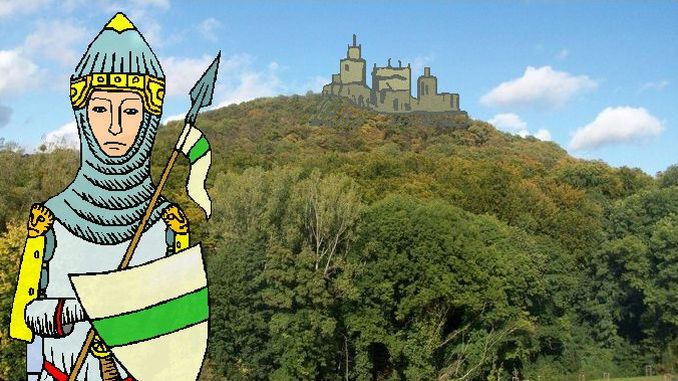
Ottonian and Salian dynasty. The Holy Roman Empire comes into being, in our region the archbishopric of Cologne.
Rhineland, around 900. Our region was part of the medieval Duchy of Lorraine in the west of the East Francia. While the Capetians continued to reign in West Francia, they had died out in East Francia.
Saxon “Ottonian” Dynasty
Henry the Fowler (919-936), Duke of Saxony, was the first non-Frank on the throne. Although there were contracts, Charlemagne’s successors in East and West Francia kept fighting over the Duchy of Lorraine. Finally, in 925, Henry took hold, and the duchy became part of East Francia for good.
His son Otto I. the Great (936-973) fought the legendary battle on the Lechfield against the Hungarians (955). His imperial coronation in 962 was the birth of the Holy Roman Empire.
Otto I and the Church
Otto was a powerful ruler, but nonetheless he had a hard time with the dukes. Therefore, he sought the support of the clergy. Bishops were appointed by the King, they did not marry and have children who inherited their title and wealth. When a bishop died, his bishopric fell back to the King who appointed a new bishop. With time, the Kings depended more on the clergymen and ceded rights to them, most of all the right to own land and build territories. The so-called Imperial Church System came into being.
Similarly, Otto’s brother Brun and close confident Brun became archbishop of Cologne and also duke of Lorraine. He was the first “imperial archbishop of Cologne and established the basis for the rise of the archbishopric.
Even after Brun’s death, a part of this duchy, a strip of land about 25 kilometers deep on the left bank of the Rhine from Rolandseck in the south to Rheinberg in the north, remained as secular property to the archbishops of Cologne. Here, they were not only ecclesiastical dignitaries, but also secular lords.
The sarcophagus of Otto’s daughter-in-law, empress Theophanu (981-991), stands in the church of St. Pantaleon, Cologne.
Salian Dynasty
Under the following Salian dynasty, the Empire went through major changes. Henry III (1035-1056), appointed bishops, abbots, even popes and did away with anti-popes.
Sacred Kingdom
Most people considered the King God’s representative on earth. On the other hand, the King, very religious and ascetic himself, supported the religious reform movement coming from the monastery of Cluny in France. The reformers demanded that the Church returned to its true tasks instead of striving for wealth and sumptuousness, and that the clergymen lived according to very strict rules. Moreover, Cluny insisted on the Church’s independence from any worldly power.
Investiture Controversy
This conflict, referred to as the Investiture Controversy, broke out openly between Henry IV (1056-1106), son of Henry III, and the Pope Gregory VII, a radical supporter of the reform. The Pope insisted that the Emperor submitted to his authority. When Henry appointed a bishop, the conflict escalated. The Pope excommunicated the Emperor and banned him. Thus, Henry was excluded from the society of decent people. His subjects had no longer to obey to a banned king, on the contrary, the Pope explicitly released them of all loyalty owed to the King.
Now the Dukes joined forces against the King and a civil war broke out. In this situation, Henry IV saw no other way than to do penance and hope for the Pope to soften, and he made the famous walk to Canossa (1077). Finally, Gregory VII released him from the ban. For the short term, Henry IV had regained freedom of action. At the same time, however, he had admitted how much power the ban, and by that the Pope, had over the King.
His authority was irremediably damaged, and more than that, the time of the sacred kingdom was over.
Mighty archbishops of Cologne
Meanwhile, the archbishops of Cologne had become important men in the empire. They had the privilege of crowning the king in Aachen, and they were the chancellors of the Holy Roman Empire. Let us put aside the image of a modern-day archbishop. A medieval archbishop of Cologne was both a secular and clerical duke, an influential politician and often a man of power. This is particularly true of archbishop Anno II.
In our region, this provoked a war against the local accounts, the Ezzonids. Anno was victorious, now he was the most powerful man in the region. Shortly afterwards Anno founded Michaelsberg Abbey in Siegburg. In the Siebengebirge, the archbishopric of Cologne now owned the villages Königswinter and Ittenbach with the mountains Wolkenburg and Drachenfels.
Romanesque churches in Cologne
The Salian kings gave us the great Romanesque cathedrals in Speyer, Worms and Mainz. But also in Cologne, Romanesque churches came into being. Maria im Kapitol, St. George and St. Aposteln are outstanding examples of medieval sacral architecture of the 11th century.
First crusade
During the Salian dynasty, the age of the crusades began (1096-1270), After the Turkish Seljuks had conquered Syria and Palestine and stopped the Christian pilgrimages to Jerusalem, Pope Urban II called upon the Christian knights to go on crusade. Many knights from the Rhineland left for Palestine, a theme that we find in various legends.
Henry V takes power
The long reign of Henry IV, even his entire life was marked by conflicts. At the end of his life, his own son Henry rebelled against him, supported by the Pope and the German dukes.
Yet, as soon as Henry V (1106-1125) had ascended the throne, he continued his father’s policy, and the Investiture Controversy continued. He travelled to Rome and, with the sword in his hand, forced the Pope to crown him emperor. But the day that Henry left, the Pope revoked, and the German dukes rebelled against the king.
Back then in the Siebengebirge
Archbishop Friedrich I. of Schwarzenburg got involved in the fights between Henry IV and Henry V. Eventually, he broke with Henry V and became the leader of an opposition against him. With the citizens of Cologne as his allies, he defeated him at the battle of Andernach in 1114. The emperor lost not only the Rhineland, but all northern Germany.
This is the political background against which the first castles in our region came into being. To secure the southern border of his territory, archbishop Friedrich hat the castles Wolkenburg (before 1118) and Rolandseck (1127-1131) built. He died at Wolkenburg Castle in October 1131. Unfortunately, nothing has remained of the castle, only a sketch (above), which gives us an idea of its appearance.
Many years later, emperor Henry V signed a compromise with the pope, the Worms Concordat in 1122.
A look beyond the Rhineland
The first spouse of the Saxon Otto I the Great was Eadgyth (910-946), a princess born to the Anglo-Saxon royal House of Wessex.
After William the Conqueror’s victory in the Battle of Hastings 1066, the Norman conquest of England began (Norman Britain, 1066-1154). Wilhelm’s son and successor was Henry I, his daughter Matilda married Henry V, the last emperor of the Salian dynasty. After his death, she kept her title as Empress and married Geoffrey of Anjou. Her father Henry I nominated her as his heir, but the Anglo-Norman barons did not approve. After Henry’s death, Matilda’s cousin Stephen of Blois took the throne. Years of anarchy followed. Eventually, in 1154, Matilda’s son with Geoffrey ascended the throne as Henry II.
Middle Ages
Intro Middle Ages | Ottonian and Salian Dynasties | Hohenstaufen Dynasty | Late Middle Ages

Be the first to comment